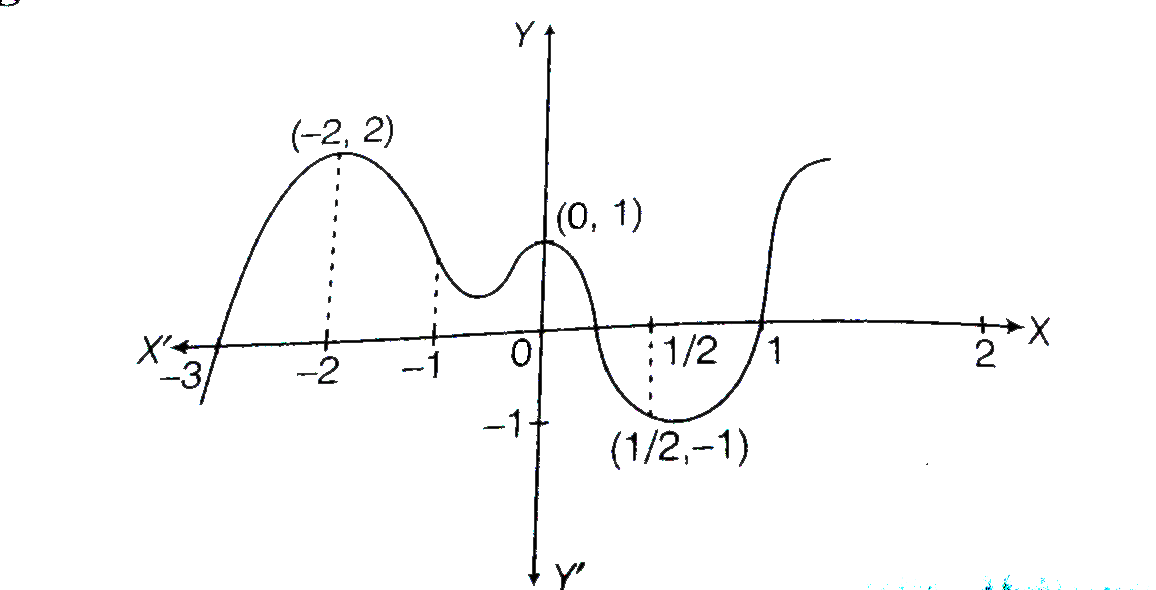If f(x)=x3−12x+p,p∈{1,2,3,…,15} and for each 'p', the number of real roots of equation f(x)=0 is denoted by θ, the 15∑θ is equal to ……….. .
The correct Answer is:9
To solve the problem, we need to analyze the function f(x)=x3−12x+p and determine the number of real roots it has for each integer value of p in the set {1,2,3,…,15}. We will denote the number of real roots for each p as θ and then calculate 15∑θ.
1. Find the derivative of f(x):
f′(x)=3x2−12
This derivative will help us find the critical points.
2. Set the derivative to zero to find critical points:
3x2−12=0⟹x2=4⟹x=−2,2
So, the critical points are x=−2 and x=2.
3. Determine the behavior of f(x) at the critical points:
- Calculate f(−2):
f(−2)=(−2)3−12(−2)+p=−8+24+p=16+p
- Calculate f(2):
f(2)=(2)3−12(2)+p=8−24+p=−16+p
4. Analyze the values of f(−2) and f(2):
- For f(−2)≥0:
16 + p \geq 0 \implies p \geq -16 \quad \text{(always true since p \in \{1, 2, \ldots, 15\} )}
- For f(2)≤0:
-16 + p \leq 0 \implies p \leq 16 \quad \text{(always true since p \in \{1, 2, \ldots, 15\} )}
5. Determine the number of real roots based on the critical points:
- Since f(x) is a cubic polynomial, it can have either 1 or 3 real roots.
- The function changes from positive to negative or vice versa at the critical points, which indicates the presence of real roots.
6. Evaluate the number of roots for p=1,2,…,15:
- For p=1: f(−2)=17 (positive), f(2)=−15 (negative) → 3 real roots.
- For p=2: f(−2)=18 (positive), f(2)=−14 (negative) → 3 real roots.
- Continuing this way, for p=3 to p=15, f(−2) remains positive and f(2) remains negative → 3 real roots for each p.
7. Count the total number of roots:
- Since there are 15 values of p and each gives 3 real roots, we have:
∑θ=15×3=45
8. Calculate 15∑θ:
15∑θ=15×45=9
Final Answer:
15∑θ=9
f′(x)=3x2−12
This derivative will help us find the critical points.
3x2−12=0⟹x2=4⟹x=−2,2
So, the critical points are x=−2 and x=2.
- Calculate f(−2):
f(−2)=(−2)3−12(−2)+p=−8+24+p=16+p
- Calculate f(2):
f(2)=(2)3−12(2)+p=8−24+p=−16+p
- For f(−2)≥0:
16 + p \geq 0 \implies p \geq -16 \quad \text{(always true since p \in \{1, 2, \ldots, 15\} )}
- For f(2)≤0:
-16 + p \leq 0 \implies p \leq 16 \quad \text{(always true since p \in \{1, 2, \ldots, 15\} )}
- Since f(x) is a cubic polynomial, it can have either 1 or 3 real roots.
- The function changes from positive to negative or vice versa at the critical points, which indicates the presence of real roots.
- For p=1: f(−2)=17 (positive), f(2)=−15 (negative) → 3 real roots.
- For p=2: f(−2)=18 (positive), f(2)=−14 (negative) → 3 real roots.
- Continuing this way, for p=3 to p=15, f(−2) remains positive and f(2) remains negative → 3 real roots for each p.
- Since there are 15 values of p and each gives 3 real roots, we have:
∑θ=15×3=45
15∑θ=15×45=9
15∑θ=9
Topper's Solved these Questions
- BOOK - ARIHANT MATHS ENGLISHCHAPTER - FUNCTIONSEXERCISE - Exercise (Subjective Type Questions)13videos
FUNCTIONS
- BOOK - ARIHANT MATHS ENGLISHCHAPTER - FUNCTIONSEXERCISE - FUNCTION EXERCISE 7: Subjective Type Questions1videos
FUNCTIONS
- BOOK - ARIHANT MATHS ENGLISHCHAPTER - FUNCTIONSEXERCISE - FUNCTION EXERCISE 5: Matching Type Questions2videos
FUNCTIONS
- BOOK - ARIHANT MATHS ENGLISHCHAPTER - ESSENTIAL MATHEMATICAL TOOLS EXERCISE - Exercise (Single Integer Answer Type Questions)3videos
ESSENTIAL MATHEMATICAL TOOLS
- BOOK - ARIHANT MATHS ENGLISHCHAPTER - GRAPHICAL TRANSFORMATIONSEXERCISE - Exercise (Questions Asked In Previous 13 Years Exam)10videos
GRAPHICAL TRANSFORMATIONS
Similar Questions
Find the number of real roots of the equation f(x)=x3+2x2+x+2=0
View SolutionThe minimum number of real roots of equation (p''(x))2+p'(x).p'''(x)=0
 View Solution
View SolutionIf the sum of square of roots of equation x2+(p+iq)x+3i=0 is 8, then find p and q, where p and q are real.
View SolutionIf p,q∈{1,2,3,4,5} , then find the number of equations of form p2x2+q2x+1=0 having real roots.
View SolutionIf p,q∈{1,2,3,4,5} , then find the number of equations of form p2x2+q2x+1=0 having real roots.
View SolutionIf f(x)=2x3−3x2+1 then number of distinct real solution (s) of the equation f(f(x))=0 is/(are) k then 7k102 is equal to_______
View SolutionLet f (x)= x3-3x+1. Find the number of different real solution of the equation f (f(x) =0
View SolutionIf p,q,∈{1,2,3,4}, then find the number of equations of the form px2+qx+1=0 having real roots.
View SolutionLet p,qε{1,2,3,4}. The number of equations of the form px2+qx+1=0 having real roots, is
View SolutionThe sum of the real roots of the equation
∣∣ ∣∣x−6−12−3xx−3−32xx+2∣∣ ∣∣=0, is equal toView Solution

